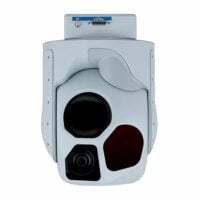EO/IR (electro-optical/infrared) systems combine visible light sensors with infrared sensors, providing operational capabilities during the day, at night and in low-light or low-visibility conditions.
They are used for a variety of defense applications that involve enhancing situational awareness, including ISR (intelligence, surveillance and reconnaissance), search and rescue, threat detection and target identification, and protecting against IR-guided missiles.
Electro-Optical Infrared Systems
EO/IR systems can be divided into two broad categories – imaging and non-imaging.
Non-imaging EO/IR systems are used to detect what are known as point targets, which are small enough to appear as a single point within the resolution of the sensor. These are used to detect the presence of threats such as enemy aircraft, missiles, and drones, and tend to focus on detecting unusual amounts of emitted energy rather than capturing significant detail.
Imaging EO/IR systems are used to detect what are known as extended targets, and can also be used to detect point targets. EO/IR imaging systems may aim to capture full detail of extended targets in the same way as other camera systems, or may capture images of the sky and then look for point targets within that image.
EO/IR Technologies
EO/IR technologies include scanning and staring systems. Scanning systems use a linear array of one or more rows of detectors, and sweep this array across the scene. Staring systems use a rectangular array of detectors to capture an entire image at once.
EO/IR Sensors
EO/IR sensors may capture light in the visible and ultraviolet wavelengths, as well as short, medium and long-wave infrared (SWIR/MWIR/LWIR). The choice of wavelengths will depend on the application of the system and the targets it is designed to detect. The IR cameras may be cooled or uncooled, with cooled systems typically offering longer range and greater sensitivity but being bulkier and more expensive.
EO/IR Gimbals & Mounts
EO/IR systems may be enclosed in pods or stabilized gimbals for easy mounting on aircraft, helicopters and UAVs (unmanned aerial vehicles), or may be mounted on tripods and other structures for fixed-site applications such as base defense and counter-UAS.



















